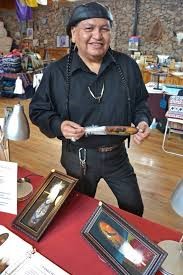Lorenzo Black Lance
Lorenzo Black Lance, of Brulé and Yankton Sioux descent, was born September 13, 1956, in Wagner, South Dakota, on the Yankton Reservation. He attended elementary schools in South Dakota and Minnesota and graduated from Todd County High School in Mission, South Dakota, on the Rosebud Reservation in 1974.
Black Lance’s early artistic training included workshops sponsored by the Sand Painters Art Club in Valentine, Nebraska. His talent quickly gained recognition—earning Best in Show at the Siouxland Art Club Show in Mission, South Dakota (1974), second place at the Black Hills Art Association Show in Rapid City, South Dakota (1974), and the Award of Excellence at the Sand Painters Art Club Show in Valentine, Nebraska (1975). His work was also represented in the South Dakota Memorial Art Center Traveling Art Exhibit, and he illustrated the cover of Buckskin Tokens by R.D. Thiesz.
A versatile artist, Black Lance worked in acrylics, oil, watercolor, collage, pencil, pastel, and charcoal. His art was devoted to subjects depicting Lakota and Dakota life, portraits, and community themes. He contributed murals to the Todd County High School girls’ dormitory with support from the Bureau of Indian Affairs, and accepted commissions such as oil paintings for Father Bob of the House of Friendship in St. Francis, South Dakota.
In addition to his art, from 1974 to 1977 Black Lance served as Lakota Studies Instructor in the Todd County Independent School District and later as manager of the Sicangu Arts and Crafts enterprise in Rosebud, South Dakota.
Until his passing on November 14, 2024, Lorenzo Black Lance remained dedicated to celebrating and preserving Lakota heritage through his art, teaching, and community leadership. His legacy endures in both his creative works and his contributions to cultural education.
